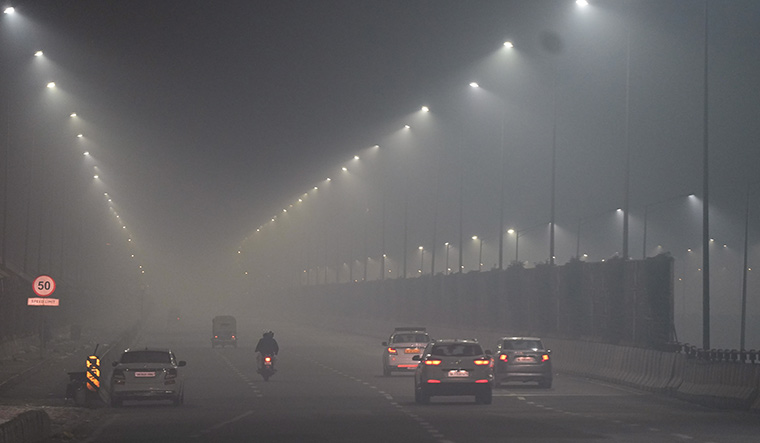COME WINTER AND Delhiites get trapped in an unhealthy, suffocating atmosphere with dangerously high levels of air pollution. In some places of Delhi-NCR (National Capital Region), the Air Quality Index touches the alarmingly high level of 1,000, as officials and politicians look for scapegoats or try to adopt strict measures to check the spiralling pollution. What is galling is that the administrations―both at the Centre and in states like Punjab, Haryana and Delhi―allow the same situation to continue year after year, putting Delhiites, particularly the elderly and children, at risk.
But they may not be entirely to blame.
Vehicular traffic, stubble burning in states like Punjab and Haryana, construction activity, small scale industries―all contribute to the growth of pollution in Delhi. However, one factor which has been least emphasised is the regular weather phenomenon of ‘inverse thermal air’. It is virtually the essential condition for the kind of high levels of pollution seen for days on end by Delhiites. It is a phenomenon that occurs when the natural flow of hot and cold air is reversed.
Usually as we go up in the sky, air pressure and density go down and air becomes cooler. The temperature decreases. With thermal inversion, the temperature increases as we go up. This happens because during winters, surface temperature and air cool faster at the ground level, while the sky remains warm. All the pollution at the surface level gets trapped at the ground with no way out, as the cold air does not rise up. There is hardly any wind blowing to take away the trapped pollution.
Thermal inversion traps pollutants such as vehicle and industrial emissions and the dust and smoke from farm fires in Punjab and Haryana under the invisible layer of warm air on top which acts as a lid, not allowing the pollution to move up and disperse freely. If air temperature falls below its dew point on the ground, then fog forms. Thermal inversion leads to smog which is the fog and smoke to be seen in the capital, particularly in the mornings and evenings with lack of precipitation and low visibility.
During the winter months, the thick haze blocks sunlight from penetrating the air and warming the ground. Farm fires or burning of stubble account for around 10 per cent of Delhi’s pollution. As much as 41 per cent of air pollution in Delhi is contributed by emissions by vehicles, while demolition and construction activities account for 30 per cent. Smoke, dust and pollutant particles in the smog are really dangerous to inhale. Emission from vehicles is also a major cause of concern because the number of private cars in Delhi is around 3.38 million. This is despite the fact that nearly five million vehicles were deregistered following an order banning diesel vehicles and petrol vehicles that completed 10 years and 15 years, respectively, in the NCR.
Air pollution is reported to be responsible for more than 6.5 million deaths each year globally. The pollutants which cause health problems include ground-level ozone, carbon, nitrogen oxides, sulfur oxides, volatile organic compounds, polycyclic aromatic hydrocarbons and fine particulate matter. It is the fine particulate matter in the air which poses serious health hazards as it goes into the lung tissues. Particulate matter is composed of chemicals such as sulfates, nitrates, carbon or mineral dusts. Fine particulate matter is supposed to be 30 times thinner than human hair.
Air pollution has been directly linked to birth outcomes and exposure to particulate matter could lead to low birth weight and pre-term babies. Cases of asthma and bronchitis are also related to particulate matter in the environment. Bettering air quality is important to improve cognitive function and to reduce dementia risk.
Due to thermal inversion, pollutants near the surface layer of air remain at the breathing level, making it unbreathable. Solutions to the problem include providing farmers with viable crop residue disposal alternatives and promoting residue management machinery or biomass energy production. Encouraging walking, cycling and using public transport, too, can bring down air pollution. With less rainfall and wind speed, pollutants are not washed away or diluted by fresh air.
According to the World Health Organization, lungs of nearly half the children in Delhi are damaged because of poor air quality. It has also increased the risk of cancer, epilepsy and diabetes among children. Rains brought a dip in pollution levels, but Delhiites showed a complete lack of civic sense by ignoring Supreme Court orders and burning crackers during Diwali. Pollution levels subsequently slipped back to ‘severe’ once again.
Official apathy and petty politics should not come in the way of curbing air pollution. Instead of blaming each other, politicians and officials must work together to find solutions.
―Mohapatra is a journalist and author.


